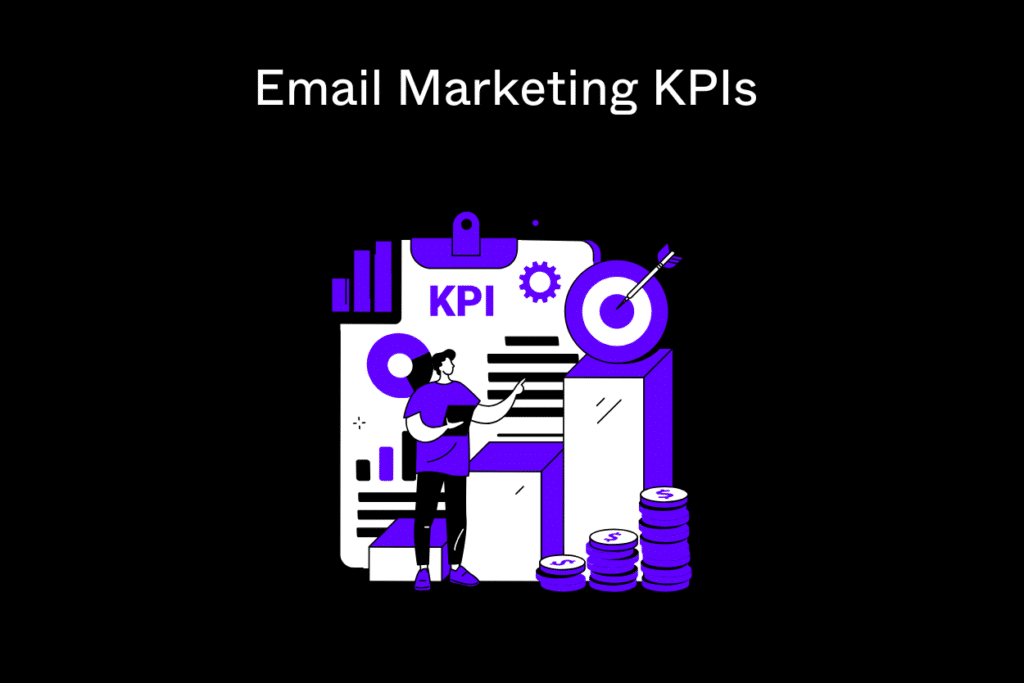
Email marketing remains one of the most effective channels for reaching and engaging your audience, but measuring its success requires more than just sending out emails and hoping for the best. Understanding and tracking key performance indicators (KPIs) is essential for optimizing your strategy, improving engagement, and driving results.
But what exactly are these KPIs, and why should you care? In this blog, we’ll explore the essential email marketing KPIs that can guide your efforts, helping you make data-driven decisions and achieve your marketing goals.
What are Email Marketing KPIs?
Email marketing KPIs are measurable values used by marketers to gauge the effectiveness of their email marketing campaigns. These metrics give insights into how well your emails perform, including how many people open your emails, click on links, and ultimately convert into paying customers.
By tracking these indicators, you can identify what’s working, what’s not, and where you need to make adjustments. The ultimate goal is to ensure that your email marketing efforts contribute positively to your overall business objectives.
10 Best Email Marketing KPIs to Track
To make the most of your email marketing, you should monitor several key metrics. Here are the top 10 Email Marketing KPIs you should track:
1. Clickthrough Rate (CTR)
Clickthrough rate measures the percentage of email recipients who clicked on one or more links in your email. It is calculated by dividing the number of clicks by the number of delivered emails, then multiplying by 100.
The average click-through rate for an email marketing campaign is 1.4%
This metric is important because it helps you understand how well your content and call-to-action resonate with your audience. A low CTR might indicate that your email content isn’t engaging enough or that your call-to-action is not compelling. To improve CTR, consider A/B testing different elements such as email layout, copy, and button design.
2. Open Rate
The open rate measures the percentage of recipients who opened your email. It’s calculated by dividing the number of unique opens by the number of delivered emails and then multiplying by 100. A higher open rate indicates that your subject line and preview text are effective in capturing the recipient’s attention.
However, keep in mind that open rates are affected by factors such as email deliverability and spam filters. To boost open rates, experiment with personalized subject lines, time of sending, and segmentation to target the right audience.
Email open rates remain fairly steady throughout the week, with Saturday slightly leading at 37.6%.
Source: Forbes
3. Conversion Rate
Conversion rate tracks the percentage of email recipients who completed a desired action after clicking on a link in your email. This action could be anything from making a purchase to signing up for a webinar or downloading a resource. Conversion rate is calculated by dividing the number of people who took the desired action by the total number of emails delivered, and then multiplying by 100.
This KPI is crucial for understanding how effectively your email campaigns drive real business outcomes. To improve conversion rates, focus on the user experience after the click, such as landing page optimization and personalized content.
4. Bounce Rate
Bounce rate measures the percentage of emails that could not be delivered to recipients' inboxes. There are two types of bounces: hard bounces and soft bounces. Hard bounces occur when the email address is invalid or no longer in use, while soft bounces happen due to temporary issues such as a full inbox or a server problem. '
The average bounce rate for an email marketing campaign is 10.4%.
A high bounce rate can harm your sender reputation and deliverability. To reduce bounce rates, regularly clean your email list and use double opt-in processes to ensure email addresses are valid.
5. List Growth Rate
The list growth rate measures how quickly your email list is expanding. It's calculated by subtracting the number of unsubscribes and spam complaints from the number of new subscribers, dividing the result by the total number of email addresses on your list, and then multiplying by 100.
A healthy list growth rate indicates that your audience finds value in your content and wants to stay connected. To maintain a steady growth rate, consistently offer valuable content and use lead magnets like eBooks or exclusive discounts to attract new subscribers.
6. Email Sharing/Forwarding Rate
This metric measures how often your emails are shared or forwarded by recipients. It’s calculated by dividing the number of times your email was shared or forwarded by the total number of delivered emails, then multiplying by 100. A high sharing rate can help increase brand awareness and extend the reach of your campaigns.
To encourage sharing, include social sharing buttons in your emails and craft compelling content that motivates readers to share with their network.
7. Overall ROI
Return on investment (ROI) measures the revenue generated from your email campaigns in relation to the cost of running them. It’s calculated by subtracting the total cost from the total revenue generated, dividing the result by the total cost, and then multiplying by 100.
Email marketing ROI is generally $36 for every dollar spent.
Tracking email marketing ROI helps you understand the financial effectiveness of your campaigns and make informed budgeting decisions. To improve ROI, focus on targeted segmentation, personalization, and automation to enhance the relevance of your emails.
8. Unsubscribe Rate
Unsubscribe rate measures the percentage of recipients who opt-out of receiving your emails after a campaign. It’s calculated by dividing the number of unsubscribes by the total number of delivered emails and then multiplying by 100.
While some level of unsubscribing is natural, a high rate may indicate that your content isn’t meeting expectations. To reduce unsubscribe rates, ensure that your emails are relevant and valuable to your audience, and avoid sending too many promotional messages.
9. Spam Complaint Rate
The spam complaint rate measures the percentage of recipients who marked your email as spam. It is calculated by dividing the number of spam complaints by the total number of delivered emails, then multiplying by 100. A high spam complaint rate can hurt your sender reputation, leading to deliverability issues and affecting future campaigns.
To keep this rate low, ensure you’re sending emails only to subscribers who have opted in, use a clear unsubscribe option, and avoid overly aggressive sales language or misleading subject lines.
10. Email Delivery Rate
The email delivery rate measures the percentage of emails successfully delivered to recipients' inboxes out of the total number sent. It's calculated by dividing the number of delivered emails by the total number of emails sent, then multiplying by 100.
A high delivery rate indicates that your email list is clean and your sender reputation is strong, while a low rate may suggest issues with your list quality or email content. To maintain a high delivery rate, regularly clean your email list, remove invalid addresses, and ensure your email content complies with best practices for spam filters.
Conclusion
Email marketing KPIs are essential for understanding the effectiveness of your campaigns and driving continuous improvement. By tracking these metrics, you can gain valuable insights into what resonates with your audience, make data-driven decisions, and optimize your email marketing strategy to achieve better results. Remember, the key to success is not just collecting data but also interpreting it correctly and using it to guide your marketing efforts.
Incorporate these KPIs into your email marketing analysis, and you'll be well on your way to achieving better engagement, higher conversions, and a more significant return on investment.
References: https://www.forbes.com/advisor/business/software/email-marketing-statistics/



![Marketing Manager Salary in India: Factors, Benefits, and Career Growth [2025]](https://wdcweb.com/wp-content/uploads/2023/01/Marketing-Manager-Salary-in-India.png)
